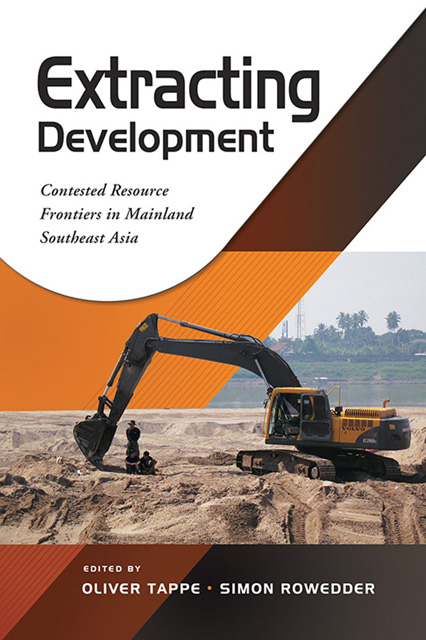Book contents
- Frontmatter
- Contents
- Acknowledgements
- The Contributors
- 1 Contested Resource Frontiers in Mainland Southeast Asia: An Introduction
- 2 Ontological Politics of the Resource Frontier: A Hydrosocial Analysis of the Mekong River in Northern Thailand
- 3 Reassembling Frontiers for Middle-Income Peasants: Rubber Expansion and Livelihood Ecosystem Transformation in a Northeast Thai Village
- 4 “Only the Best Fruits for China!”: Local Productions of a ‘Fruit Frontier’ in the Borderlands of China, Laos and Thailand
- 5 Commodity Frontiers in Motion: Tracing the Maize Boom across the Lao-Vietnamese Borderlands
- 6 New Frontier Spaces: Complex Entanglements and Power Relations (Re)shaping Land Governance in Laos
- 7 Moving Away from the Margins? How a Chinese Hydropower Project Made a Lao Community Modern and Comfortable
- 8 Frontier Capitalism in Colonial and Contemporary Laos: The Case of Tin Mining
- 9 Chinese Investments and Resource Frontiers in Cambodia: Systemic Transformation
- 10 The Open Issues: Cases between Chinese Investment Companies and Local People in Myanmar
- 11 Internationalization of RMB and Tin Ore Trade in China-Myanmar Frontier Governance: Views from Yunnan Province
- Index
5 - Commodity Frontiers in Motion: Tracing the Maize Boom across the Lao-Vietnamese Borderlands
Published online by Cambridge University Press: 30 June 2023
- Frontmatter
- Contents
- Acknowledgements
- The Contributors
- 1 Contested Resource Frontiers in Mainland Southeast Asia: An Introduction
- 2 Ontological Politics of the Resource Frontier: A Hydrosocial Analysis of the Mekong River in Northern Thailand
- 3 Reassembling Frontiers for Middle-Income Peasants: Rubber Expansion and Livelihood Ecosystem Transformation in a Northeast Thai Village
- 4 “Only the Best Fruits for China!”: Local Productions of a ‘Fruit Frontier’ in the Borderlands of China, Laos and Thailand
- 5 Commodity Frontiers in Motion: Tracing the Maize Boom across the Lao-Vietnamese Borderlands
- 6 New Frontier Spaces: Complex Entanglements and Power Relations (Re)shaping Land Governance in Laos
- 7 Moving Away from the Margins? How a Chinese Hydropower Project Made a Lao Community Modern and Comfortable
- 8 Frontier Capitalism in Colonial and Contemporary Laos: The Case of Tin Mining
- 9 Chinese Investments and Resource Frontiers in Cambodia: Systemic Transformation
- 10 The Open Issues: Cases between Chinese Investment Companies and Local People in Myanmar
- 11 Internationalization of RMB and Tin Ore Trade in China-Myanmar Frontier Governance: Views from Yunnan Province
- Index
Summary
“If all of you only grow rice, you cannot get out of poverty.”—Farmer, Ban Phoukhao (citing maize trader).
INTRODUCTION
We met the naiban (village head) on a cool morning near his field hut, at the foot of the hills surrounding Ban Homphou, Houaphan province, Laos. The hut overlooked paddy fields to which the naiban's wife was piping water from the nearby stream, a tributary of the Nam Ma, enabling them to produce two rice crops per year, as with the handful of other households in the village with paddy land. This provided his family with about 20 sacks of rice for consumption, but much of the limited paddy area in the village had been damaged by heavy erosion further up the mountain slopes during the previous rainy season, resulting from consecutive seasons of monoculture maize. The loss of paddy land had contributed to a general expansion of upland rice and maize in the village, to compensate for lost wet-rice production, signifying the extent to which the commodity crop of maize had become insinuated within formerly subsistence-oriented livelihoods. The first job of the day was to sharpen the “pa” (Figure 5.1), hooked machetes we then used to clear a maize field on the hillside above us. The field was covered with thick brush, as the naiban planted the land with maize every second year with a one-year fallow, which he found marginally more productive than continuous cropping. As we worked, the naiban spoke of how many households in the village had become increasingly reliant on maize: “The main product here is maize now, if people have to stop growing maize, they don't know what to do.”
This chapter examines the circumstances behind the initiation of commercial maize in the mid-2000s in two villages near the mountainous border between Houaphan province, Laos and Son La province, Vietnam, upon which the naiban and households had come to consider themselves dependent by the time of this research. The analysis that follows was informed throughout by a multi-sited study conducted from 2016 to 2018, comprising a household component in the two study villages, with periods of participant observation throughout the maize production cycle, random-sampled (n=30 per village) household surveys, purposive-sampled key informant interviews (nineteen per village) and gender-specific focus group discussions (three per village).
Information
- Type
- Chapter
- Information
- Extracting DevelopmentContested Resource Frontiers in Mainland Southeast Asia, pp. 106 - 128Publisher: ISEAS–Yusof Ishak InstitutePrint publication year: 2022
